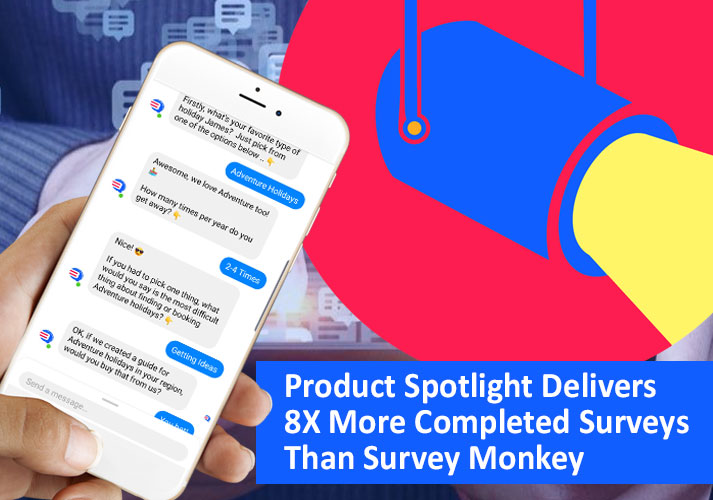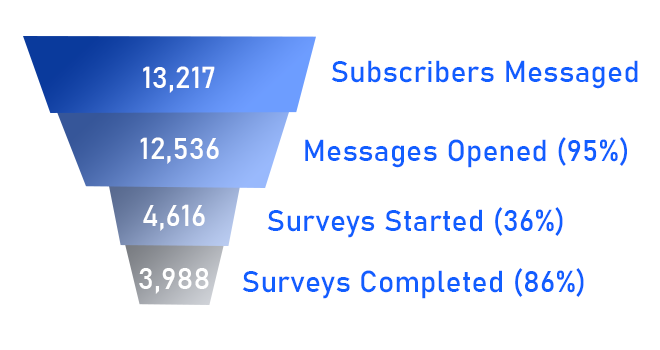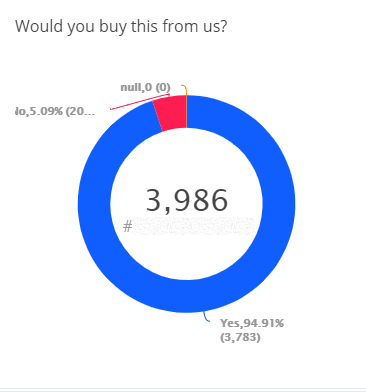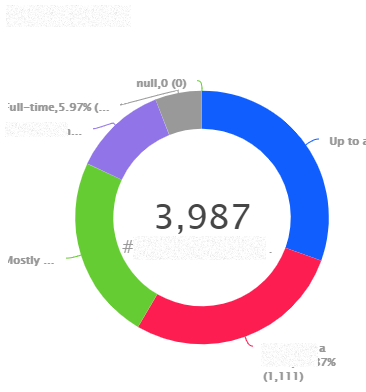
With today’s giant marketplaces like Amazon, eBay and AliExpress, it’s easy to find new product ideas to add to your brand. If you’re just getting started out, doing the basic research is all you need.
However, if you already have an active brand, there’s a big gap between a promising high-selling product on Amazon and a knock-out success for your own business.
The best way to validate your ideas is to chat with your existing customers. What better way to leverage your customer relationships? Why not get nearly 5000 past customers to tell you exactly what product they want to buy next, as happened for one of Beyond Points’ customers! In this Case Study we explore exactly what techniques we used and how you can sleep better at night knowing your next product will be a winner!
How to Find Potential Products
There is a wealth of knowledge online that can kick start your product research. Most gurus in the eCommerce space will show you how to use existing tools to identify hot selling or in-vogue products, determine their profitability, figure out how to make them better, and then find a supplier.
We’ve listed out some of our favourite tools as well as tips for early stage product research below.
5 Tips & Tools for Early Stage Product Research
- Find ideas for hot selling products by looking on Amazon, specifically best seller rankings and search position. Our favourite tool for taking a lot of the leg work out of this is Black Box by Helium10
- Triangulate these ideas by checking out similar products on eBay and AliExpress. Great tools for this are WatchCount and AliShark
- Test the profitability of your shortlisted product to see if they have enough volume and margin to give you ample opportunities to spend on marketing and traffic generation. Helium10 also has some great tools here, but Jungle Scout gets our tip purely based on the amount of data they’ve collected over the years.
- Make sure you’re on the right side of the search trend by checking your main keywords in Google Trends and Merchant Words
- Figure out when the main problems with existing product are by downloading and comparing reviews. Again, a great tool is Review Downloader by Helium10.
We don’t wish to take anything away from these tools & techniques, because they’re great resources. However profit in eCommerce doesn’t come from selling more products to more people. Profit comes from comes from increasing your customer lifetime value.
Quite simply, you must discover what your existing customers need, and then make the exact products they want to buy from your brand
How to find products your customers are desperate to buy
Using the tools outlined above is absolutely no guarantee that your product selection resonates with your niche. If it doesn’t make sense for your brand it won’t compel your existing customers to dig out their credit card.
With potentially substantial sums of money on the line to acquire inventory, how much better would it be to know your customers will take action before you start production?
Such was the conundrum for one of our customers recently. They came to us with a variety of ideas, but like most brand owners, product managers and store owners, wanted more certainty around their selections.
They wanted to:
- 1) Identify which product(s) their customers wanted next
- 2) Make sure their customers would buy that product from their brand, and
- 3) Build list of engaged customers hungry for the product to launch!
Having deployed Messenger-based surveys several times in the past, Beyond Points knew just how to help. In this article we share our approach, results, and make recommendations on how to get the best results from product research surveys.
Why Messenger for Surveys?
Firstly, let’s take a quick look at why the chat channel is a better resource than more traditional survey methods.
Customer Communication has changed. Today, the majority of people prefer to have short conversations on channels they are already using to chat with family and friends, often several times a day.
While building surveys using tools like Survey Monkey is a lot more sophisticated than it used to be, conducting research inside Messenger is the closest thing there is to having a conversation over the phone. In many ways it’s much better.
For one thing, you can conduct it at scale with no resource cost, yet still get meaningful results in just a few hours. In our case, we ran the survey over 7 days, but there’s no reason you couldn’t do a ‘flash survey’ if you wanted to get even more rapid feedback.
Perhaps more importantly, building a Messenger bot survey allows you to probe deeper on specific topics depending on the customer’s answers.
Lastly, because the conversation can take place at a time and pace comfortable for your customer, you get amazing completion rates.
With that background, lets dive into the case study.
How we constructed the Conversation
Our client actually had a LOT of questions to ask. Quietly, we had concerns given the depth and variety of information sought. The survey would take user commitment to complete and we had doubts whether a sufficient number of customers would get all the way through.
In the end we settled on 10 questions (which is still a lot for Messenger). We knew the key to getting a high completion would be keeping it light, so each question was brief and easy to scan-read.
It’s also important to understand that a Messenger conversation is not quite like a real face-to-face conversation. After sending a chat message, there are any number of things that can distract them from reacting to your responses. For that reason, weaving in some clever logic to politely nudge them along is critical to getting high completion rates.
We designed the survey to be highly modular, with timeouts that triggered reminders if questions went unanswered. These gentle nudges helped to keep the conversation moving forward.
Despite the channel’s meteoric rise, not everyone will want to engage with your brand on Messenger. To support our customer’s more traditional audience, it was decided to send a Survey Monkey request to email subscribers, as well as the chatbot survey to their Messenger subscribers.
The Results
| Email to Survey Monkey
82,000 Subscribers |
Broadcast to Messenger
13,217 Subscribers Messaged |
|---|
The results were nothing short of sensational, & shows once again the incredible engagement level for brands who leverage the new era of chat marketing!
With a contactable list only 1/5th the size of the email audience, the Messenger survey delivered over 8X the number of completed surveys!
Putting it a different way, Messenger subscribers were 50X more valuable than email subscribers for getting actionable product research insights!
Perhaps better still, of the 4616 people who chose to enter the survey, a staggering 3988 (86%) completed all 10 questions!

With live statistics presented on our customised Chat Marketing dashboard, the client was able to watch the data unfold in real time {we’ve blanked out some parts to protect the client’s valuable insights }..

Most importantly, the combination of closed questions, multiple choice and freeform text (with some basic semantic analysis), provided outstanding clarity to the client on the best choice of products going forwards.
| Closed Questions | Multiple Choice |
 |
 |
| Semantic Free Text | |
 |
|
Our 5 Tips for Running a Successful Messenger Product Survey
- 1) Structure your questions so that later questions drill in deeper based on earlier answers
- 2) Design the quiz in a modular way with good tagging so you can trigger reminders and keep the conversation moving forwards
- 3) Keep each question short and carefully test your text for readability
- 4) Use a mix of closed questions, multiple choice and free text to ensure you get clear results
- 5) Incentivise entry to encourage as many people as possible to take part
Did the Survey Meet the Objectives?
Our client has come away with 3 key insights & assets
- 1) Absolute clarity on the stand-out product that over 60% of their customer base stated they wanted to purchase!
- 2) A new list of products to explore in 2020
- 3) An engaged list of customers who are eagerly awaiting the next product release!
Ask Your Customers
With time, brand reputation, not to mention capital on the line, releasing new products is risky.
The value of engaging customers in product research cannot be overstated. Aside from the clarity this Beyond Points client now has, they were able to take rapid action to get production underway for their next product in record time.
Perhaps just as importantly, their customers feel heard and accounted for.
Ask yourself, how much more eagerly will these customers now share the news with their friends, engage in future offers and contribute to reviews and other user generated content to build social proof?
Because Messenger is a familiar, near real-time conversation medium, it represents an unprecedented channel of getting engaging customers and getting their feedback.
If you’re looking to expand your product line, asking your existing customers in Messenger is a great way to sense-check your ideas and pick the best match for your niche.
Plus, you’ll be building a rich launch list poised to go viral the moment you release (or even pre-release) your product. You’ll never need to feel the pain of long-term storage fees from a slow moving product, or have to run soul-destroying fire sales ever again!
Want to discover the details of how we leveraged the Product Spotlight for this client?
For a full breakdown, including conversation design, structure and more details of the amazing results, tap below to get the full Case Study via Facebook Messenger.

